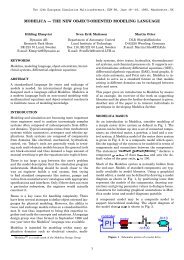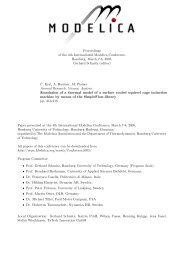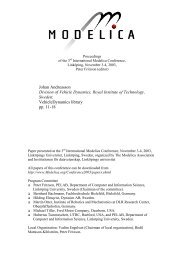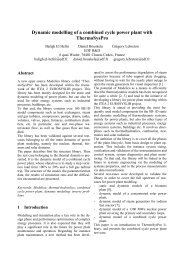Hilding Elmqvist, Hubertus Tummescheit and Martin Otter ... - Modelica
Hilding Elmqvist, Hubertus Tummescheit and Martin Otter ... - Modelica
Hilding Elmqvist, Hubertus Tummescheit and Martin Otter ... - Modelica
Create successful ePaper yourself
Turn your PDF publications into a flip-book with our unique Google optimized e-Paper software.
H. <strong>Elmqvist</strong>, H. <strong>Tummescheit</strong>, M. <strong>Otter</strong> Object-Oriented Modeling of Thermo-Fluid Systems<br />
package SimpleAir<br />
...<br />
redeclare model BaseProperties<br />
import <strong>Modelica</strong>.SIunits.<br />
conversions.*;<br />
extends(<br />
p(stateSelect = ..),<br />
T(stateSelect = ..)<br />
);<br />
constant Real R_air = 287.0506;<br />
constant Real h0 = 274648.7;<br />
equation<br />
p = d*R_air*T;<br />
h = 1005.45*T + h0;<br />
u = h – p/d;<br />
end BaseProperties;<br />
...<br />
end SimpleAir;<br />
The “stateSelect = ...” statements read<br />
stateSelect =<br />
if preferedMediumStates then<br />
StateSelect.prefer<br />
else<br />
StateSelect.default<br />
This is the essential definition to decouple balance<br />
<strong>and</strong> medium equations: “preferedMediumStates” is<br />
a Boolean parameter defined in PartialMedium. In<br />
every device that needs medium properties for<br />
balance equations in the form of differential<br />
equations, this flag has to be set to true. If no<br />
derivatives of any of the 5+nX basic thermodynamic<br />
variables are needed, this flag has to be set to false.<br />
Due to the above if-expression, the stateSelect<br />
attributes of the independent medium variables are<br />
set to “prefer” if preferedMediumStates = true.<br />
This in turn means that implicitly equations of the<br />
form “pd = der(p)“ <strong>and</strong> „Td = der(T)“ are present<br />
<strong>and</strong> that p <strong>and</strong> T should be selected as states, if this<br />
is possible. This is important, if the property<br />
functions, such as u(p,T) are non-linear in the<br />
independent variables. If the independent variables<br />
would not be selected as states, this would result in<br />
non-linear systems of equations for the inversion of<br />
the property function.<br />
The balance equations <strong>and</strong> the medium<br />
equations together with the above definition of<br />
preferred states define a DAE (= Differential<br />
Algebraic Equation system) of index 2. For<br />
example, if p <strong>and</strong> T are used as independent medium<br />
variables, this DAE consists of the following<br />
equations:<br />
// medium equations<br />
d = d(<br />
p,<br />
T )<br />
u = u(<br />
p,<br />
T )<br />
h = h(<br />
p,<br />
T )<br />
pd = p&<br />
Td = T&<br />
// balance equations<br />
m = d ⋅V<br />
U = m ⋅u<br />
dm<br />
= ... // mass balance<br />
dt<br />
dU<br />
= ... // energy balance<br />
dt<br />
<strong>Modelica</strong> models often result in higher index DAEs.<br />
Dymola solves this problem by using (a) the<br />
Pantelides algorithm (Pantelides (1988)) to<br />
determine the equations that have to be<br />
differentiated <strong>and</strong> (b) the dummy derivative method<br />
(Mattsson <strong>and</strong> Söderlind (1993), Mattsson et.al.<br />
(2000)) to select appropriate states. For the above<br />
code fragment, the Pantelides algorithm determines<br />
that the equations of m, U <strong>and</strong> therefore also of d<br />
<strong>and</strong> u need to be differentiated resulting in the<br />
following additional equations:<br />
m&<br />
= V ⋅ d&<br />
U&<br />
= m&<br />
⋅u<br />
+ m ⋅u&<br />
d d<br />
d&<br />
∂ ∂<br />
= ⋅ p&<br />
+ ⋅T&<br />
∂p<br />
∂T<br />
∂u<br />
∂u<br />
u&<br />
= ⋅ p&<br />
+ ⋅T&<br />
∂p<br />
∂T<br />
With the dummy derivative method it is possible to<br />
select p <strong>and</strong> T as states from the original set of<br />
potential states (p,T,m,U), especially since p <strong>and</strong> T<br />
have the “prefer” attribute. Using symbolic formula<br />
manipulation it is possible to solve the above<br />
equations efficiently for p T&<br />
&, .<br />
Note, it is important to set the stateSelect<br />
attribute to its default value when<br />
preferedMediumStates = false. Otherwise, a tool<br />
would have to compute the derivative of p <strong>and</strong> T,<br />
although these derivatives are not needed. Worse, in<br />
order to compute these derivatives most likely other<br />
device equations would have to be differentiated.<br />
After implementation of the BaseProperties<br />
model, the optional functions supported by the<br />
medium model have to be defined, e.g., a constant<br />
dynamic viscosity for the simple air model:<br />
The <strong>Modelica</strong> Association <strong>Modelica</strong> 2003, November 3-4, 2003

















